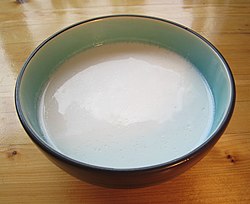Coconut milk
 |
|
| Region or state | Tropical region |
|---|---|
| Main ingredients | Coconut |
| |
|
| Nutritional value per 100 g | |
|---|---|
| Energy | 962 kJ (230 kcal) |
|
5.5 g
|
|
| Sugars | 3.3 g |
| Dietary fibre | 2.2 g |
|
23.8 g
|
|
| Saturated | 21.1 g |
| Monounsaturated | 1.0 g |
| Polyunsaturated | 0.26 g |
|
2.3 g
|
|
| Vitamins | |
| Vitamin A equiv. |
(0%)
0 μg
(0%)
0 μg |
| Thiamine (B1) |
(3%)
0.03 mg |
| Riboflavin (B2) |
(0%)
0 mg |
| Niacin (B3) |
(5%)
0.76 mg |
| Pantothenic acid (B5) |
(4%)
0.18 mg |
| Vitamin B6 |
(2%)
0.03 mg |
| Folate (B9) |
(4%)
16 μg |
| Vitamin C |
(3%)
2.8 mg |
| Vitamin E |
(1%)
0.15 mg |
| Vitamin K |
(0%)
0.1 μg |
| Minerals | |
| Calcium |
(2%)
16 mg |
| Iron |
(12%)
1.6 mg |
| Magnesium |
(10%)
37 mg |
| Manganese |
(44%)
0.92 mg |
| Phosphorus |
(14%)
100 mg |
| Potassium |
(6%)
263 mg |
| Sodium |
(1%)
15 mg |
| Zinc |
(7%)
0.67 mg |
| Other constituents | |
| Water | 67.6 g |
|
|
|
|
|
| Percentages are roughly approximated using US recommendations for adults. | |
Coconut milk is the liquid that comes from the grated meat of a mature coconut. The opacity and rich taste of coconut milk are attributed to its high oil content, most of which is saturated fat. Coconut milk is a popular food ingredient used in Southeast Asia, the Caribbean, and northern South America.
Coconut milk is distinguished from coconut water by its thicker consistency and milkier appearance. Unlike coconut water, which is the liquid found directly inside a coconut, coconut milk is the result of combining coconut water with coconut meat.
Coconut milk is traditionally made by grating the white inner flesh of a brown coconut and mixing the shredded coconut meat with a small amount of water in order to suspend the fat present in the grated meat. The grating process can be carried out manually or by comminution, a process that uses a more modern grating machine to facilitate the grating. Coconut milk exists in two grades: thick and thin. Thick coconut milk contains 20-22% fat while thin coconut milk contains 5-7% fat. Thick milk is prepared by directly squeezing grated coconut meat through cheesecloth. Thin milk is produced by soaking the squeezed coconut meat in water and further squeezing the meat until a thinner liquid forms. Thick milk contains soluble, suspended solids, which makes it a good ingredient for desserts and rich and dry sauces. Because thin milk does not contain these soluble solids, it is mainly used in general cooking. The distinction between thick and thin milk is not usually made in Western nations due to the fact that fresh coconut milk is uncommon in these countries and most consumers buy coconut milk in cartons or cans.
Coconut milk has a fat content of 24%, depending on the fat level of the coconut meat and the quantity of added water. When refrigerated and left to set, coconut cream will rise to the top and separate out from the milk. To avoid this in commercial coconut milk, an emulsifier and a stabiliser have to be used.
...
Wikipedia
